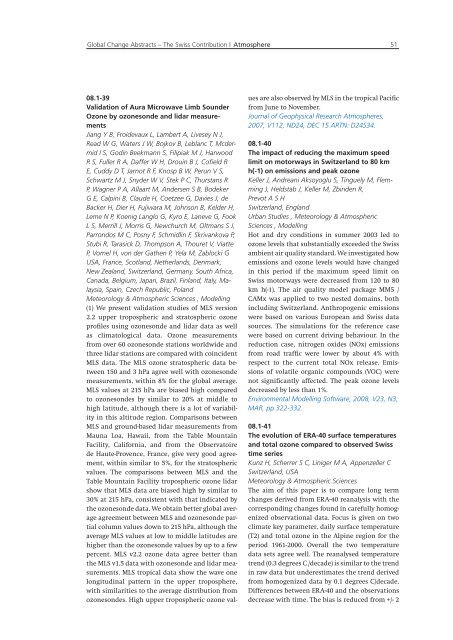Global Change Abstracts The Swiss Contribution - SCNAT
Global Change Abstracts The Swiss Contribution - SCNAT
Global Change Abstracts The Swiss Contribution - SCNAT
You also want an ePaper? Increase the reach of your titles
YUMPU automatically turns print PDFs into web optimized ePapers that Google loves.
<strong>Global</strong> <strong>Change</strong> <strong>Abstracts</strong> – <strong>The</strong> <strong>Swiss</strong> <strong>Contribution</strong> | Atmosphere 51<br />
08.1-39<br />
Validation of Aura Microwave Limb Sounder<br />
Ozone by ozonesonde and lidar measurements<br />
Jiang Y B, Froidevaux L, Lambert A, Livesey N J,<br />
Read W G, Waters J W, Bojkov B, Leblanc T, Mcdermid<br />
I S, Godin Beekmann S, Filipiak M J, Harwood<br />
R S, Fuller R A, Daffer W H, Drouin B J, Cofield R<br />
E, Cuddy D T, Jarnot R F, Knosp B W, Perun V S,<br />
Schwartz M J, Snyder W V, Stek P C, Thurstans R<br />
P, Wagner P A, Allaart M, Andersen S B, Bodeker<br />
G E, Calpini B, Claude H, Coetzee G, Davies J, de<br />
Backer H, Dier H, Fujiwara M, Johnson B, Kelder H,<br />
Leme N P, Koenig Langlo G, Kyro E, Laneve G, Fook<br />
L S, Merrill J, Morris G, Newchurch M, Oltmans S J,<br />
Parrondos M C, Posny F, Schmidlin F, Skrivankova P,<br />
Stubi R, Tarasick D, Thompson A, Thouret V, Viatte<br />
P, Vomel H, von der Gathen P, Yela M, Zablocki G<br />
USA, France, Scotland, Netherlands, Denmark,<br />
New Zealand, Switzerland, Germany, South Africa,<br />
Canada, Belgium, Japan, Brazil, Finland, Italy, Malaysia,<br />
Spain, Czech Republic, Poland<br />
Meteorology & Atmospheric Sciences , Modelling<br />
(1) We present validation studies of MLS version<br />
2.2 upper tropospheric and stratospheric ozone<br />
profiles using ozonesonde and lidar data as well<br />
as climatological data. Ozone measurements<br />
from over 60 ozonesonde stations worldwide and<br />
three lidar stations are compared with coincident<br />
MLS data. <strong>The</strong> MLS ozone stratospheric data between<br />
150 and 3 hPa agree well with ozonesonde<br />
measurements, within 8% for the global average.<br />
MLS values at 215 hPa are biased high compared<br />
to ozonesondes by similar to 20% at middle to<br />
high latitude, although there is a lot of variability<br />
in this altitude region. Comparisons between<br />
MLS and ground-based lidar measurements from<br />
Mauna Loa, Hawaii, from the Table Mountain<br />
Facility, California, and from the Observatoire<br />
de Haute-Provence, France, give very good agreement,<br />
within similar to 5%, for the stratospheric<br />
values. <strong>The</strong> comparisons between MLS and the<br />
Table Mountain Facility tropospheric ozone lidar<br />
show that MLS data are biased high by similar to<br />
30% at 215 hPa, consistent with that indicated by<br />
the ozonesonde data. We obtain better global average<br />
agreement between MLS and ozonesonde partial<br />
column values down to 215 hPa, although the<br />
average MLS values at low to middle latitudes are<br />
higher than the ozonesonde values by up to a few<br />
percent. MLS v2.2 ozone data agree better than<br />
the MLS v1.5 data with ozonesonde and lidar measurements.<br />
MLS tropical data show the wave one<br />
longitudinal pattern in the upper troposphere,<br />
with similarities to the average distribution from<br />
ozonesondes. High upper tropospheric ozone val-<br />
ues are also observed by MLS in the tropical Pacific<br />
from June to November.<br />
Journal of Geophysical Research Atmospheres,<br />
2007, V112, ND24, DEC 15 ARTN: D24S34.<br />
08.1-40<br />
<strong>The</strong> impact of reducing the maximum speed<br />
limit on motorways in Switzerland to 80 km<br />
h(-1) on emissions and peak ozone<br />
Keller J, Andreani Aksoyoglu S, Tinguely M, Flemming<br />
J, Heldstab J, Keller M, Zbinden R,<br />
Prevot A S H<br />
Switzerland, England<br />
Urban Studies , Meteorology & Atmospheric<br />
Sciences , Modelling<br />
Hot and dry conditions in summer 2003 led to<br />
ozone levels that substantially exceeded the <strong>Swiss</strong><br />
ambient air quality standard. We investigated how<br />
emissions and ozone levels would have changed<br />
in this period if the maximum speed limit on<br />
<strong>Swiss</strong> motorways were decreased from 120 to 80<br />
km h(-1). <strong>The</strong> air quality model package MM5 /<br />
CAMx was applied to two nested domains, both<br />
including Switzerland. Anthropogenic emissions<br />
were based on various European and <strong>Swiss</strong> data<br />
sources. <strong>The</strong> simulations for the reference case<br />
were based on current driving behaviour. In the<br />
reduction case, nitrogen oxides (NOx) emissions<br />
from road traffic were lower by about 4% with<br />
respect to the current total NOx release. Emissions<br />
of volatile organic compounds (VOC) were<br />
not significantly affected. <strong>The</strong> peak ozone levels<br />
decreased by less than 1%.<br />
Environmental Modelling Software, 2008, V23, N3,<br />
MAR, pp 322-332.<br />
08.1-41<br />
<strong>The</strong> evolution of ERA-40 surface temperatures<br />
and total ozone compared to observed <strong>Swiss</strong><br />
time series<br />
Kunz H, Scherrer S C, Liniger M A, Appenzeller C<br />
Switzerland, USA<br />
Meteorology & Atmospheric Sciences<br />
<strong>The</strong> aim of this paper is to compare long term<br />
changes derived from ERA-40 reanalysis with the<br />
corresponding changes found in carefully homogenized<br />
observational data. Focus is given on two<br />
climate key parameter, daily surface temperature<br />
(T2) and total ozone in the Alpine region for the<br />
period 1961-2000. Overall the two temperature<br />
data sets agree well. <strong>The</strong> reanalysed temperature<br />
trend (0.3 degrees C /decade) is similar to the trend<br />
in raw data but underestimates the trend derived<br />
from homogenized data by 0.1 degrees C/decade.<br />
Differences between ERA-40 and the observations<br />
decrease with time. <strong>The</strong> bias is reduced from +/- 2

















